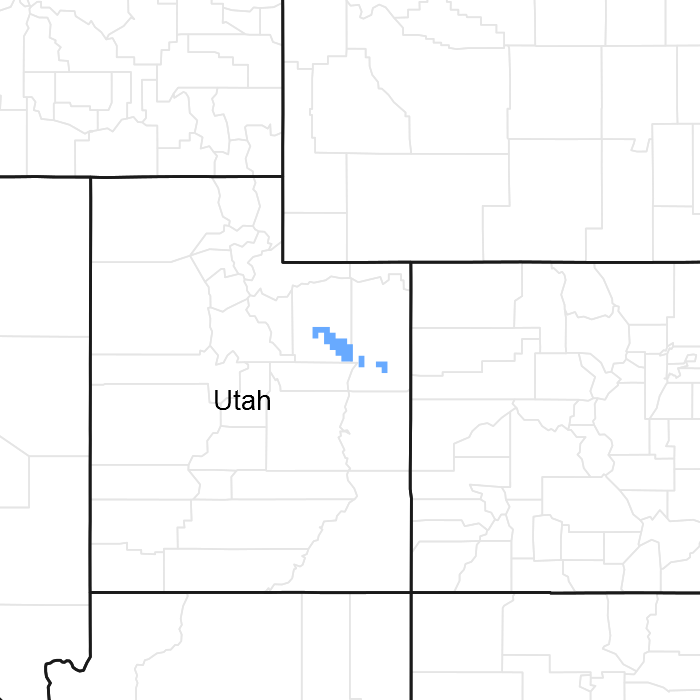Ecological dynamics
It is impossible to determine in any quantitative detail the historic climax plant community (HCPC) for this ecological site because of the lack of direct historical documentation preceding all human influence. In some areas, the earliest reports of dominant plants include the cadastral survey conducted by the General Land Office, which began in the late 19th century for this area (Galatowitsch 1990). Although there is evidence of Native Americans passing through southern extent of this ecological site, there has been no evidence of permanent inhabitance. The northern extent of this ecological site did have signs of permanent inhabitants for a short time (Spangler 1995), then became similar to the southern extent of this site. The first Europeans came to eastern Utah in 1765 as a Spanish expedition, however it wasn’t until approximately 1870 that the first Europeans brought livestock to the area (Watt 1997). Itinerant and local sheep flocks followed, largely replacing cattle as the browse component increased.
Below is a State and Transition Model diagram to illustrate the “phases” (common plant communities), and “states” (aggregations of those plant communities) that can occur on the site. Differences between phases and states depend primarily upon observations of a range of disturbance histories in areas where this ESD is represented. These situations include grazing gradients to water sources, fence-line contrasts, patches with differing dates of fire, herbicide treatment, tillage, etc. Reference State 1 illustrates the common plant communities that probably existed just prior to European settlement.
The major successional pathways within states, (“community pathways”) are indicated by arrows between phases. “Transitions” are indicated by arrows between states. The drivers of these changes are indicated in codes decipherable by referring to the legend at the bottom of the page and by reading the detailed narratives that follow the diagram. The transition between Reference State 1 and State 2 is considered irreversible because of the naturalization of exotic species of both flora and fauna, possible extinction of native species, and climate change. There may have also been accelerated soil erosion. When available, monitoring data (of various types) were employed to validate more subjective inferences made in this diagram. See the complete files in the office of the State Range Conservationist for more details.
The plant communities shown in this State and Transition Model may not represent every possibility, but are probably the most prevalent and recurring plant communities. As more monitoring data are collected, some phases or states may be revised, removed, and/or new ones may be added. Desired plant communities should be determined by the decision-makers from the options in this model. The main purpose for including descriptions of a plant community is to capture the current knowledge at the time of this revision.
State 1
Reference State
The Reference State is a description of this ecological site just prior to Euro-American settlement but long after the arrival of Native Americans. The description of the Reference State was determined by NRCS Soil Survey Type Site Location information and familiarity with rangeland relict areas where they exist. The Reference State for this site would have been a shrub steppe characterized by Wyoming big sagebrush and associated native perennial forbs and grasses. A more complete list of species by lifeform for the Reference State is available in the accompanying tables in the “Plant Community Composition by Weight and Percentage” section of this document.
Community 1.1
Wyoming big sagebrush with native perennial grasses and forbs.
This community is dominated by Wyoming big sagebrush, Indian ricegrass and galleta. Shadscale and winterfat are also commonly present in the shrub layer. Indian ricegrass and galleta are the principle perennial grasses. Bottlebrush squirreltail is also commonly present. Scarlet globemallow is an abundant forb. Natural fire frequency is estimated to be 10 to 70 years (USDA-FS).
Table 5. Annual production by plant type
| Plant type |
Low
(lb/acre) |
Representative value
(lb/acre) |
High
(lb/acre) |
| Shrub/Vine |
157 |
270 |
345 |
| Grass/Grasslike |
45 |
150 |
225 |
| Forb |
23 |
80 |
130 |
| Total |
225 |
500 |
700 |
Table 6. Ground cover
| Tree foliar cover |
0%
|
| Shrub/vine/liana foliar cover |
10-20%
|
| Grass/grasslike foliar cover |
25-35%
|
| Forb foliar cover |
5-10%
|
| Non-vascular plants |
0%
|
| Biological crusts |
0%
|
| Litter |
30-45%
|
| Surface fragments >0.25" and <=3" |
0-35%
|
| Surface fragments >3" |
1-5%
|
| Bedrock |
0%
|
| Water |
0%
|
| Bare ground |
30-45%
|
Table 7. Canopy structure (% cover)
| Height Above Ground (ft) |
Tree |
Shrub/Vine |
Grass/
Grasslike |
Forb |
| <0.5 |
– |
– |
– |
– |
| >0.5 <= 1 |
– |
– |
– |
– |
| >1 <= 2 |
– |
– |
25-35% |
5-10% |
| >2 <= 4.5 |
– |
10-20% |
– |
– |
| >4.5 <= 13 |
– |
– |
– |
– |
| >13 <= 40 |
– |
– |
– |
– |
| >40 <= 80 |
– |
– |
– |
– |
| >80 <= 120 |
– |
– |
– |
– |
| >120 |
– |
– |
– |
– |
Community 1.2
Wyoming big sagebrush and juniper
Wyoming big sagebrush and shadscale increases significantly in percent composition. Winterfat and yellow rabbitbrush may increase also. Shrubs become decadent due to age. Perennial grasses and forbs lose vigor and juniper may have begun to encroach on the site. With the plant interspaces becoming larger from the reduction of rhizomatous grasses, soil erosion may accelerate because of the increased bare ground. Water flow patterns and pedestals become more abundant. Although the overall functionality of the site is still intact, it is at risk with further degradation.
Community 1.3
Indian ricegrass, needleandthread, galleta and sprouting shrubs
Native perennial bunchgrasses dominate this community phase. Wyoming big sagebrush and shadscale decrease in the community. Winterfat has the ability to re-sprout and re-establish following a fire. Yellow rabbitbrush and horsebrush species may increase significantly following fire and much of the excess fine fuel accumulation is removed. Fire tolerant shrubs typically persist as dominants in the community for 30 years or longer. Indian ricegrass and other cool season bunchgrasses flourish.
Pathway 1.1-1.2
Community 1.1 to 1.2
Extended period of time without a major disturbance such as fire; insect damage; or prolonged drought. Fire frequency extends well beyond the 10 to 70 year average for the site
Pathway 1.1-1.3
Community 1.1 to 1.3
Recent fire occurrence, lightning or human caused, eliminating sagebrush and other non-sprouting species from the community. Site is properly grazed.
Pathway 1.2-1.3
Community 1.2 to 1.3
This pathway occurs from the occurrence of a natural or human induced fire. Site is properly grazed.
Pathway 1.3-1.1
Community 1.3 to 1.1
This represents the time following a fire with good grazing management, with a normal fire return interval of 10-70 years. Site is properly grazed.
State 2
Current Potential
This state includes plant communities dominated by a diverse mixture of perennial grasses, a mixture of Wyoming big sagebrush and perennial grasses, and a community dominated by Wyoming big sagebrush. These community phases occur depending on the time since a disturbance that kills Wyoming big sagebrush has occurred, such as fire, insects, or drought, and grazing that provides adequate duration, timing, and intensity that maintain plant vigor and health of the plant community.
Plant communities in this state can include native, acclimatized, naturalized and invasive non-native species. This state is irreversibly changed from the reference state because these non-native species will now remain a permanent part of the community.
This plant community has the composition, structure and cover present that facilitates the capture, storage, and safe release of precipitation, nutrients are being cycled through deep rooted perennial grasses, forbs, and evergreen shrubs, and cool season energy capture throughout the entire growing season (March to October) such that this plant community and site resiliency is maintained. With a lengthened fire return interval (greater than 70 years), an increase in sagebrush canopy occurs until sagebrush dominates resource use. This results in a decrease in vigor, cover and reproduction of perennial bunch grasses, and results in an increase in invasive annuals such as cheatgrass. Once junipers become a dominant feature, they are a permanent part of the plant community until a fire or management action removes them. The understory is depleted (lack of both living plants and seed bank) so that a return to State 2 is not possible.
Community 2.1
Wyoming big sagebrush/perennial native herbs with minor component of exotic species
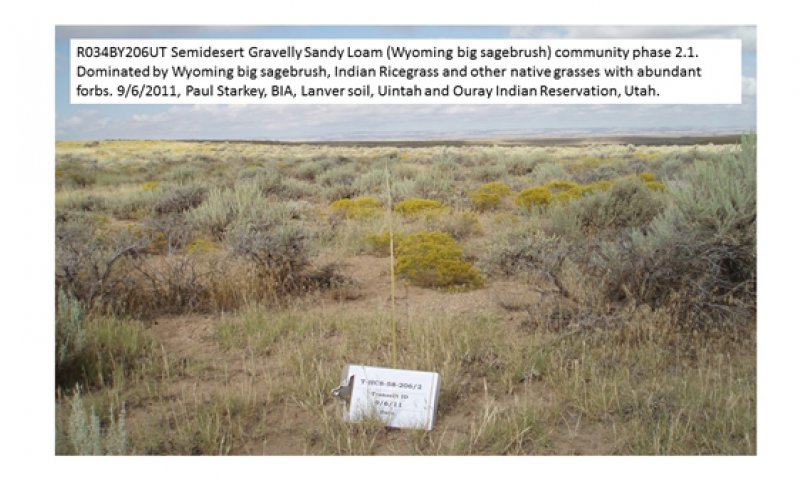
Figure 7. 2.1
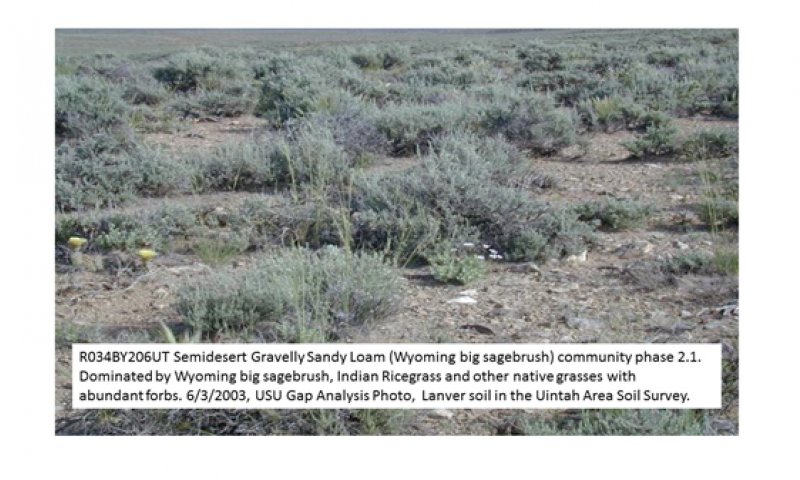
Figure 8. 2.1
This community is dominated by Wyoming big sagebrush, Indian ricegrass and galleta. Shadscale and winterfat are also commonly present in the shrub layer. Indian ricegrass and galleta are the principle perennial grasses. Bottlebrush squirreltail is also commonly present. Abundant forbs including longleaf phlox and scarlet globemallow. Naturalized and invasive non-native species also exist. Natural fire frequency is estimated to be 10 to 70 years.
| Jan |
Feb |
Mar |
Apr |
May |
Jun |
Jul |
Aug |
Sep |
Oct |
Nov |
Dec |
| J |
F |
M |
A |
M |
J |
J |
A |
S |
O |
N |
D |
Community 2.2
Perennial grasses and sprouting shrubs and scattered annual species.
Wyoming big sagebrush and Shadscale decrease in the community. Winterfat resprouts following the fire. Yellow rabbitbrush and horsebrush may increase significantly in the community following fire. Several native grasses dominate the understory. Fire tolerant shrubs typically persist as dominants in the community for 30 years or longer. The abundance of invasive annuals prior to the disturbance will dictate their abundance post disturbance.
Community 2.3
Wyoming big sagebrush with scattered juniper and depleted herbaceous understory and annuals.
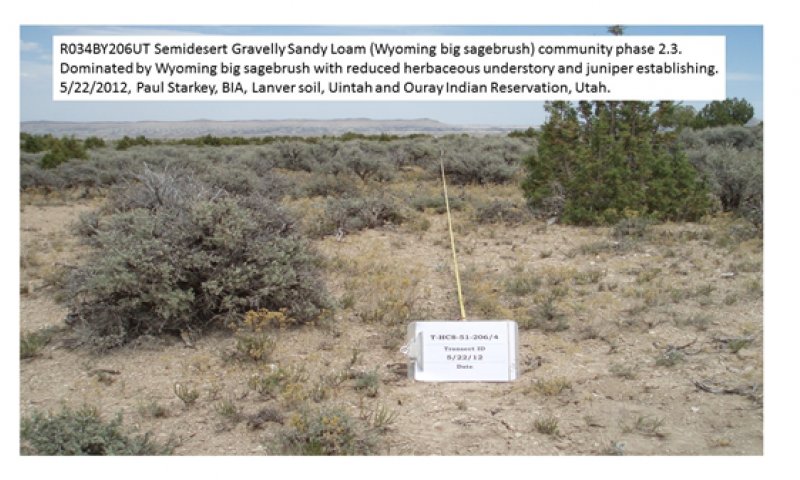
Figure 10. 2.3

Figure 11. 2.3
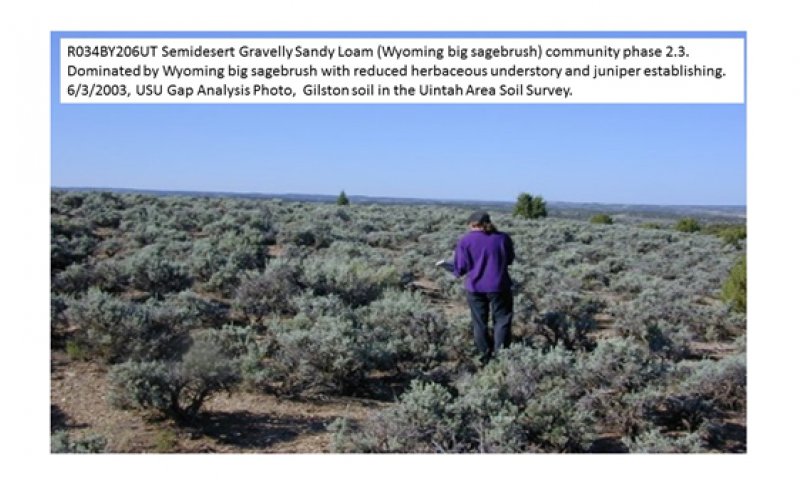
Figure 12. 2.3
Wyoming big sagebrush and shadscale increase significantly in percent composition. Winterfat and yellow rabbitbrush may increase also. Shrubs become decadent due to age. Indian ricegrass, needleandthread and other cool season bunchgrasses begin to lose vigor because of improper grazing (including, season long overstocking, wrong season, etc.) and/or increased shrub competition. Galleta increases in herbaceous cover. This community is dominated by native species, but may include acclimatized, naturalized and invasive non-native species. Utah Juniper can encroach in this community phase and is small and low in cover.
Pathway 2.1-2.2
Community 2.1 to 2.2
Fire or brush management or excessive browsing removes non-sprouting shrubs from the community.
Pathway 2.1-2.3
Community 2.1 to 2.3
Wyoming big sagebrush/perennial native herbs with minor component of exotic species
Wyoming big sagebrush with scattered juniper and depleted herbaceous understory and annuals.
Improper grazing (including season long, overstocking, wrong season, etc.) and/or drought remove annual and perennial fine fuels from the site lessening the potential for fire to occur. Fire frequency extends beyond the 10 – 70 year average for the site. Utah juniper will often invade the site if a seed source is available.
Pathway 2.2-2.1
Community 2.2 to 2.1
Site is properly grazed for an extended period of time without disturbance. Plant community succession results in an increase of non-sprouting shrubs such as sagebrush.
Pathway 2.3-2.2
Community 2.3 to 2.2
Fire, brush management or excessive browsing removes non-sprouting shrubs from the community. Yellow rabbitbrush and/or horsebrush species may become dominant.
State 3
Juniper Encroachment
Native shrubs such as Wyoming big sagebrush or rabbitbrush dominate the site. The occurrence of fire extends well beyond the normal period for the site. This state typically has invasive grasses and/or forbs as the dominant understory species. Utah junipers increase to occupy a significant portion of the over story. Wyoming big sagebrush dominates the shrub layer and may be decadent due to completion with junipers. Indian ricegrass and other native bunchgrasses are significantly reduced due to increased shrub and tree competition and/or heavy grazing pressure.
Community 3.1
Utah juniper, invasive annuals
Utah juniper has invaded, Wyoming big sagebrush and other shrubs decline. Winterfat is dead or dying. Remaining perennial herbaceous vegetation is mostly found only in protected locations under shrubs. Invasive, non-native grasses and weeds including cheatgrass, annual mustards, redstem storksbill, etc. typically dominate the understory.
Community 3.2
Juniper near Monoculture
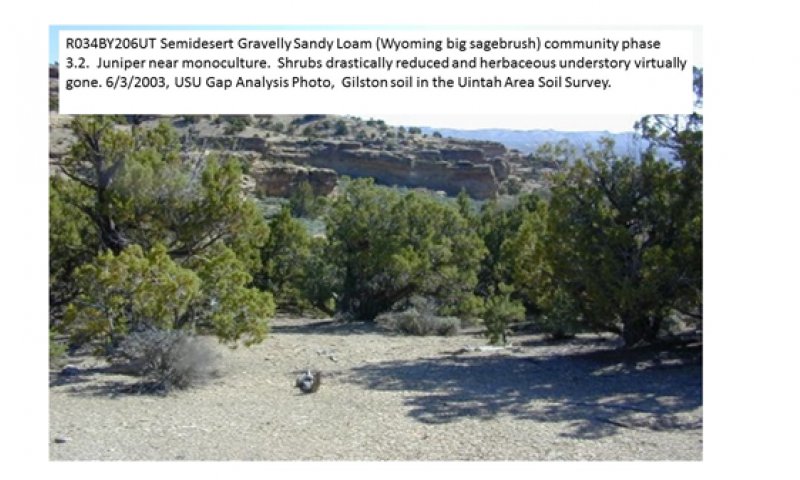
Figure 13. 3.2
The number and size of trees has increased with the absence of fire. The understory shrub and herbaceous vegetation has become very decadent or absent. A few scattered shrubs may still exist with the herbaceous component nearly nonexistent. Exposed soil results in increased runoff and erosion.
Pathway 3.1-3.2
Community 3.1 to 3.2
Lengthening of the fire return interval.
State 4
Invasive Annuals
Invasive grasses and forbs dominate this state. This may occur under a shortend fire return cycle which excludes native shrubs by frequent burning or this may occur with repeated improper grazing, or a combination of the two. Indian ricegrass and other native bunchgrasses are significantly reduced from increased annuals competition and/or heavy grazing pressure and shortened fire return interval. Only remnant perennial species remain. Highly combustible fine fuels from invasive annuals dominate the community. Reoccurring fire is common. Fire frequency is 5 – 30 years. Cheatgrass dominance prevents reestablishment of sagebrush due to competition.
Community 4.1
Invasive Annuals
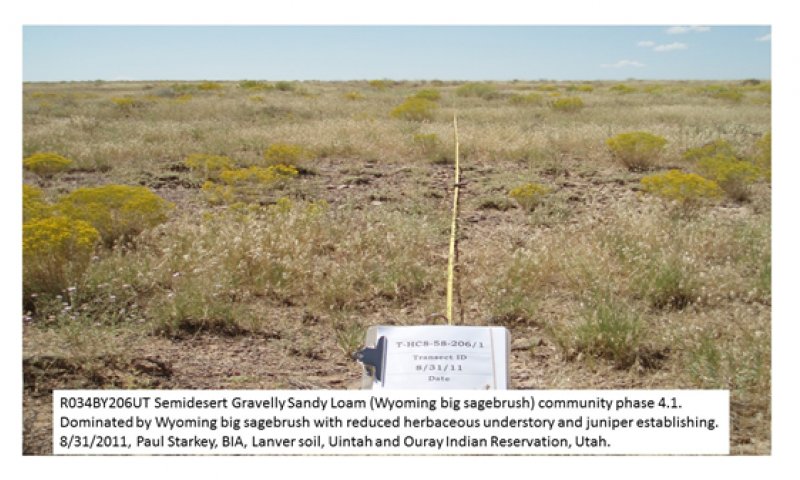
Figure 14. 4.1
Invasive annuals dominate this community phase. If shrubs are present, yellow rabbitbrush dominates the shrub layer. Remaining winterfat is mostly dead. Horsebrush species can also be plentiful if conditions are right. Fire tolerant shrubs may persist as dominants with fire periods reoccurring at intervals of 5 - 30 years. Broom snakeweed may be a dominant episodic species when conditions are favorable. Only remnant perennial bunchgrasses remain, if any; invasive annuals including cheatgrass, annual mustards, redstem storksbill, etc. dominate the understory.
State 5
Seeded State
This state is seeded to rangeland species that are composed of mostly introduced species. Unwanted trees and/or shrubs are reduced but they will occupy a portion of the site through natural succession. Invasive annual grasses and weedy forb species primarily, cheatgrass and various annual forbs, may be present in the seeding, but do not dominate. The introduced perennial grasses prevent the reestablishment of native herbaceous species due to competition, and can persist indefinitely.
Community 5.1
Introduced Perennial Grasses
This plant community is the result of a seeding of introduced grasses. Although there may be some native species present, however the introduced species will dominate the site. Shrubs are sparse to absent. Range seedings, when healthy, are usually resistant to fire.
Community 5.2
Wyoming big sagebrush, introduced perennial grasses
This community shows where sagebrush and other shrubs have slowly reestablished in the area and have become dominate or codominant with the herbaceous component.
Pathway 5.1-5.2
Community 5.1 to 5.2
Over time Wyoming big sagebrush and other shrubs gradually move back into the site. The rate of this re-colonization may depend on external factors such as climate, management and grazing (both domestic and wildlife). Re-colonization of non-sprouting shrubs requires 10-70 years without fire.
Pathway 5.2-5.1
Community 5.2 to 5.1
Site receives good grazing management. Mechanical, chemical, biological or fire disturbances reduce the woody vegetation components of the community. Perennial herbaceous vegetation becomes dominant.
State 6
Sagebrush with invasive annual understory
This state is characterized by a decadent sagebrush overstory with scattered other shrubs and the understory that is dominated by cheatgrass with scattered native grasses and forbs, caused by long-term improper grazing (including season long, overstocking, wrong season, etc.). Sagebrush and native herbaceous species cannot reestablish due to competition with cheatgrass.
Community 6.1
Sagebrush with invasive annual understory
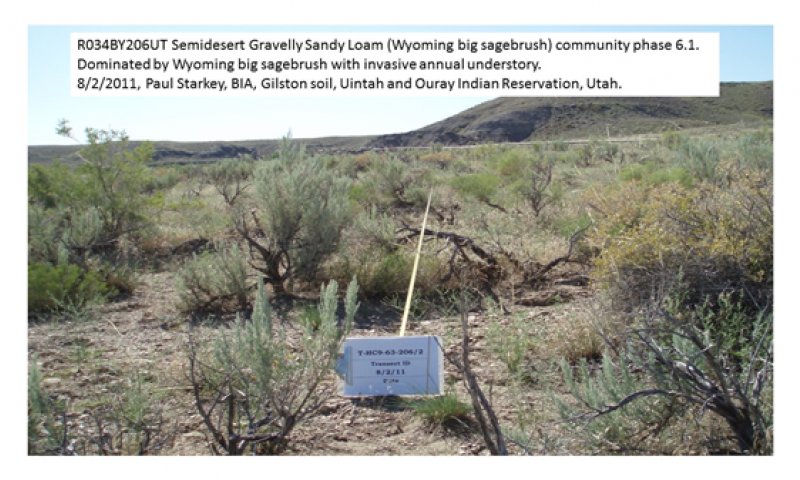
Figure 15. 6.1
Cheatgrass and other invasive annuals dominate the understory of a decadent stand of Wyoming big sagebrush. A component of other shrubs is typically present and remnant populations of native grasses and forbs may still be present. This community phase is very susceptible to wildfire due to the high amounts of fine fuels produced from the invasive annuals.
Transition 1-2
State 1 to 2
The threshold is crossed when there is an introduction of non-native species, primarily cheatgrass and various annual forbs, that become established in the community.
Transition 2-3
State 2 to 3
Sustained, long-term improper grazing (including season long, overstocking, wrong season, etc.); and/or prolonged drought. Lengthening of the fire return interval.
Transition 2-4
State 2 to 4
Long-term improper grazing (including season long, overstocking, wrong season, etc.) and/or prolonged drought; shortened fire frequency.
Transition 2-5.1
State 2 to 5
Disturbance such as a fire or brush management followed by a rangeland seeding.
Transition 2-6
State 2 to 6
Sustained, long-term improper grazing and/or the lack of fire.
Transition 3-4
State 3 to 4
Fire, with long-term improper grazing (including season long, overstocking, wrong season, etc.) and/or prolonged drought.
Restoration pathway 3-5
State 3 to 5
Fire or brush management with the seeding of introduced species with prescribed grazing.
Restoration pathway 4-5
State 4 to 5
Seeding of introduced species with prescribed grazing.
Transition 5.2-3
State 5 to 3
Invasion of the site by junipers, long-term improper grazing (including season long, overstocking, wrong season, etc.) and/or prolonged drought; lengthened fire frequency allows the site to be invaded by juniper.
Transition 5-4
State 5 to 4
Long-term improper grazing (including season long, overstocking, wrong season, etc.) and/or prolonged drought; shortened fire frequency allows the understory vegetation on the site to be dominated by invasive annuals.
Transition 6-4
State 6 to 4
Fire, with long-term improper grazing (including season long, overstocking, wrong season, etc.) and/or prolonged drought.
Restoration pathway 6-5.1
State 6 to 5
Disturbance such as a fire or brush management followed by a rangeland seeding.


